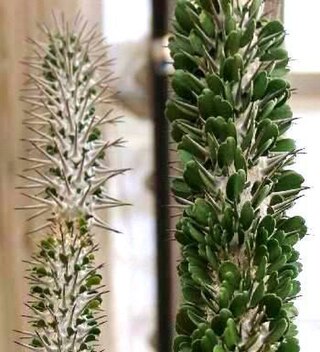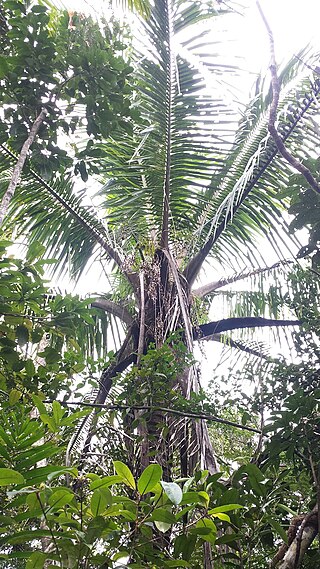
The Fabaceae or Leguminosae, commonly known as the legume, pea, or bean family, are a large and agriculturally important family of flowering plants. It includes trees, shrubs, and perennial or annual herbaceous plants, which are easily recognized by their fruit (legume) and their compound, stipulate leaves. The family is widely distributed, and is the third-largest land plant family in number of species, behind only the Orchidaceae and Asteraceae, with about 765 genera and nearly 20,000 known species.

Paubrasilia echinata is a species of flowering plant in the legume family, Fabaceae, that is endemic to the Atlantic Forest of Brazil. It is a Brazilian timber tree commonly known as Pernambuco wood or brazilwood and is the national tree of Brazil. This plant has a dense, orange-red heartwood that takes a high shine, and it is the premier wood used for making bows for stringed instruments. The wood also yields a historically important red dye called brazilin, which oxidizes to brazilein.

Didiereaceae is a family of flowering plants found in continental Africa and Madagascar. It contains 20 species classified in three subfamilies and six genera. Species of the family are succulent plants, growing in sub-arid to arid habitats. Several are known as ornamental plants in specialist succulent collections. The subfamily Didiereoideae is endemic to the southwest of Madagascar, where the species are characteristic elements of the spiny thickets.

The subfamily Detarioideae is one of the subdivisions of the plant family Fabaceae (legumes). This subfamily includes many tropical trees, some of which are used for timber or have ecological importance. The subfamily consists of 84 genera, most of which are native to Africa and Asia. Pride of Burma and tamarind are two of the most notable species in Detarioideae. It has the following clade-based definition:
The most inclusive crown clade containing Goniorrhachis marginataTaub. and Aphanocalyx cynometroidesOliv., but not Cercis canadensisL., Duparquetia orchidaceaBaill., or Bobgunnia fistuloides(Harms) J. H. Kirkbr. & Wiersema.

The Madagascar spiny forests is an ecoregion in the southwest of Madagascar. The vegetation type is found on poor substrates with low, erratic winter rainfall. The ecoregion contains an outstanding proportion of endemic plant species and is listed as one of the 200 most important ecological regions in the world; one of the Global 200.
Stuhlmannia moavi is a species of flowering plants in the legume family, Fabaceae. It is the only species in the genus Stuhlmannia. It is a tree native to Kenya, Tanzania, and Madagascar, where it grows in seasonally-dry tropical forest, woodland on limestone, and in riverine forest. The genus belongs to tribe Caesalpinieae in subfamily Caesalpinioideae.
Dalbergia baronii is a species of flowering plant in the legume family Fabaceae. It is endemic to Madagascar. It is named after the English missionary and botanist Rev. Richard Baron.
Dalbergia monticola is a species of flowering plant in the legume family Fabaceae. It is endemic to Madagascar. It occurs at higher elevation, which gave the species its name.
Phylloxylon is a genus of flowering plants in the Indigofereae tribe of the family Fabaceae. There are seven species, all endemic to Madagascar.

Voanioala gerardii, commonly known as the forest coconut, is a species of flowering plant in the family Arecaceae. It is a relative of the coconut, and is generally regarded as monotypic within the genus Voanioala. However, a team of geneticists headed by Bee F. Gunn found sufficient genetic variation within Voanioala to constitute at least two and possibly four cryptospecies. Voanioala is endemic to Madagascar, and is threatened by habitat loss. Voanioala is harvested for its edible seeds and palm heart. It is estimated that there are fewer than 15 mature trees remaining.
Duparquetia orchidacea is a liana which is native to tropical west Africa. It is the only species in the subfamily Duparquetioideae. It is found in humid tropical forests in West and Central Africa. It is a basal member of the Fabaceae, as evidenced by the distinctive structure of its flowers and wood, and phylogenetic studies.
Brenierea insignis is a species of flowering plants in the legume family, Fabaceae. It belongs to the subfamily Cercidoideae and is the only member of the genus Brenierea. It is endemic to Madagascar.
Mendoravia is a genus of flowering plants in the family Fabaceae. It belongs to the subfamily Dialioideae. It contains a single species, Mendoravia dumaziana, a tree endemic to southeastern Madagascar. It is known by the common names mendoravy, mendoravy fotsy, and mendoravy mainty.
Viguieranthus is a genus of flowering plants in the legume family, Fabaceae. It belongs to the mimosoid clade of the subfamily Caesalpinioideae. It includes 18 species of trees and shrubs native to Madagascar and the Comoro Islands. 17 species are endemic to Madagascar, and one also extends to the Comoros. Typical habitats are tropical lowland and submontane humid forest and seasonally-dry woodland, thicket, and scrubland.
Sylvichadsia is a genus of flowering plants in the family Fabaceae. It includes four species of trees, shrubs, or lianas endemic to Madagascar. They grow in humid tropical rain forest in eastern and northern Madagascar, often near rivers and streams. The genus belongs to subfamily Faboideae.
Malagasia is a monotypic genus of trees in the family Proteaceae. The sole species is Malagasia alticola, endemic to Madagascar.
Craspidospermum is a monotypic genus of plant in the family Apocynaceae endemic to Madagascar. As of August 2013 the World Checklist of Selected Plant Families recognises the single species Craspidospermum verticillatum.

The flora of Madagascar consists of more than 12,000 species of plants, as well as a poorly known number of fungi and algae. Around 83% of Madagascar's vascular plants are found only on the island. These endemics include five plant families, 85% of the over 900 orchid species, around 200 species of palms, and such emblematic species as the traveller's tree, six species of baobab and the Madagascar periwinkle. The high degree of endemism is due to Madagascar's long isolation following its separation from the African and Indian landmasses in the Mesozoic, 150–160 and 84–91 million years ago, respectively. However, few plant lineages remain from the ancient Gondwanan flora; most extant plant groups immigrated via across-ocean dispersal well after continental break-up.
Schizolaena hystrix is a tree in the family Sarcolaenaceae. It is endemic to Madagascar. The specific epithet hystrix is from the Latin meaning "spiny", referring to the porcupine-like appearance of the involucre.

The subfamily Dialioideae is one of the subdivisions of the plant family Fabaceae (legumes). This subfamily includes many tropical trees and shrubs. The subfamily consists of 17 genera, which are widespread throughout the tropics. It has the following clade-based definition:
The most inclusive crown clade containing Poeppigia proceraC.Presland Dialium guianense(Aubl.) Sandwith, but not Cercis canadensisL., Duparquetia orchidaceaBaill., or Bobgunnia fistuloides(Harms) J. H. Kirkbr. & Wiersema









